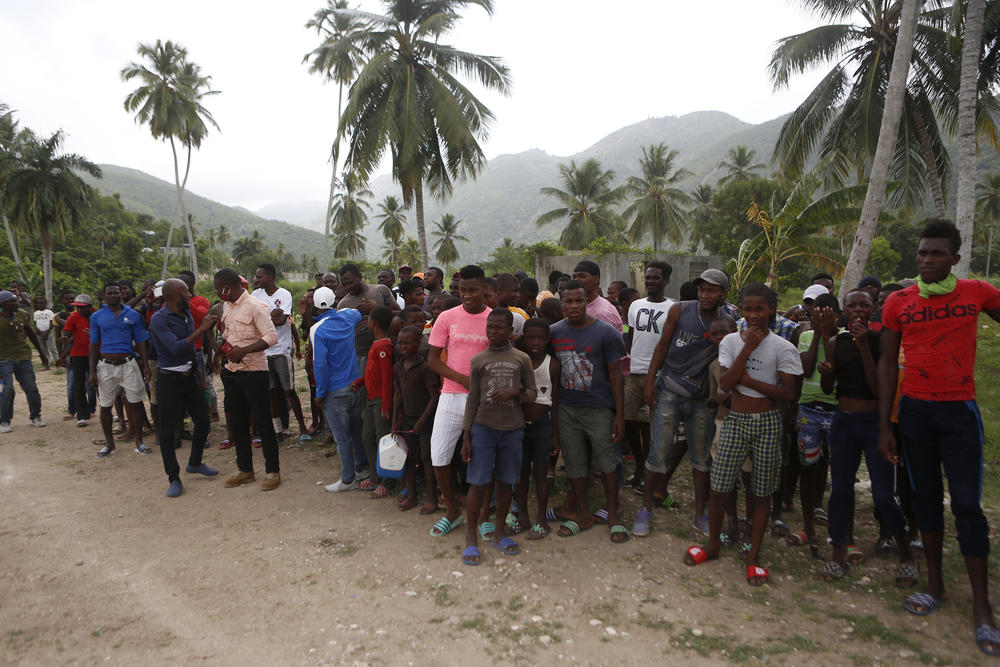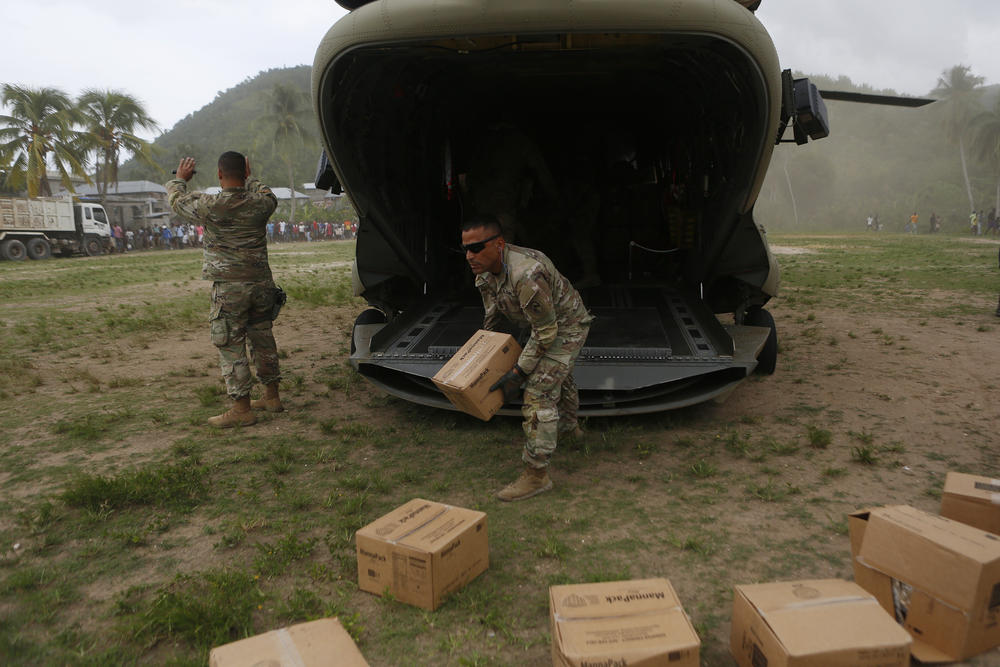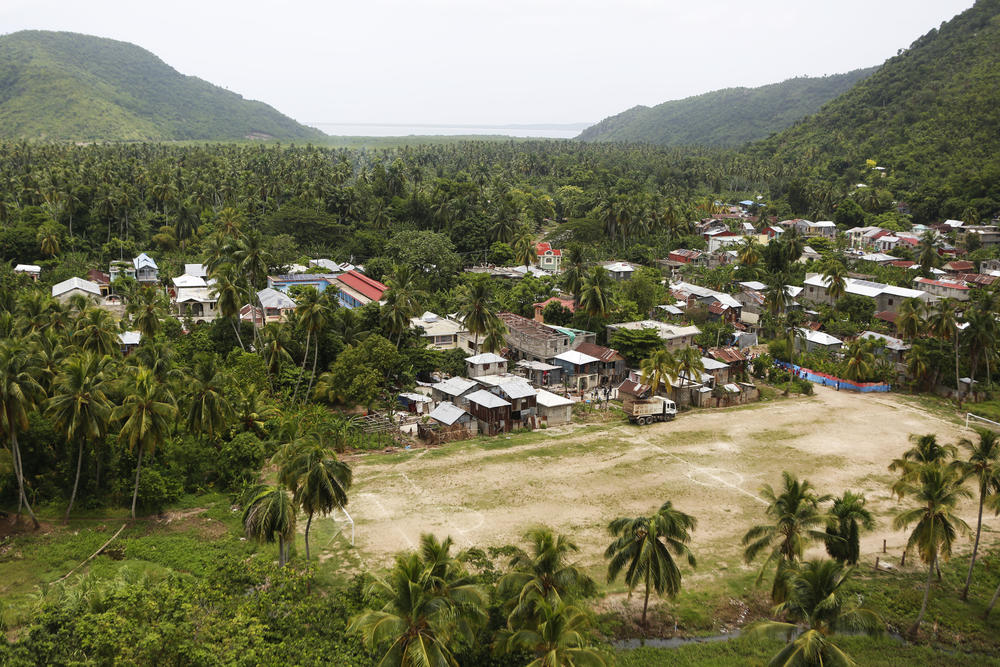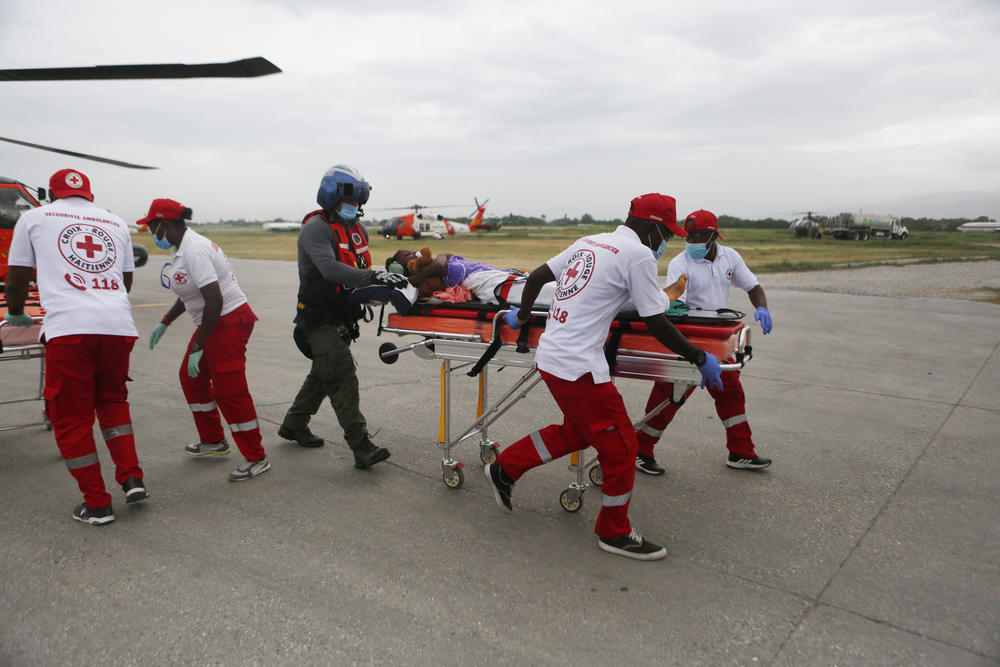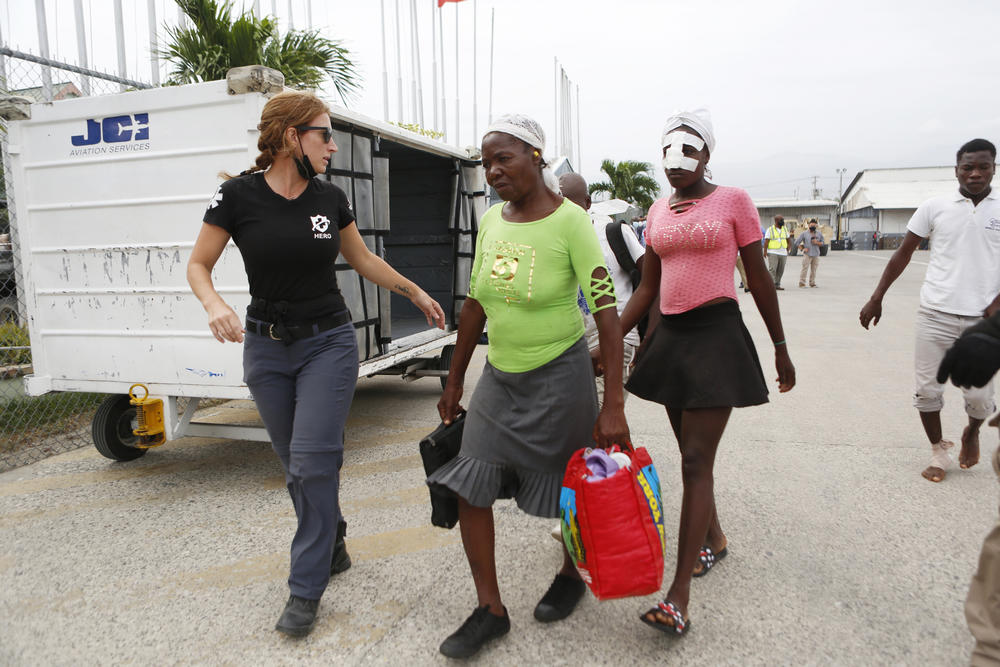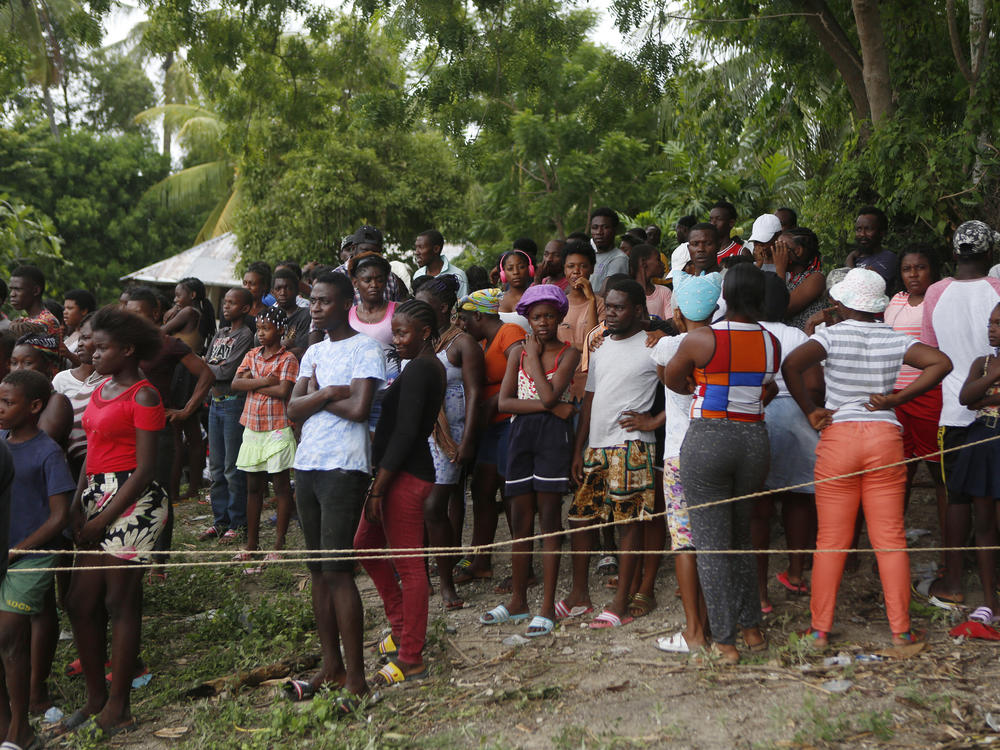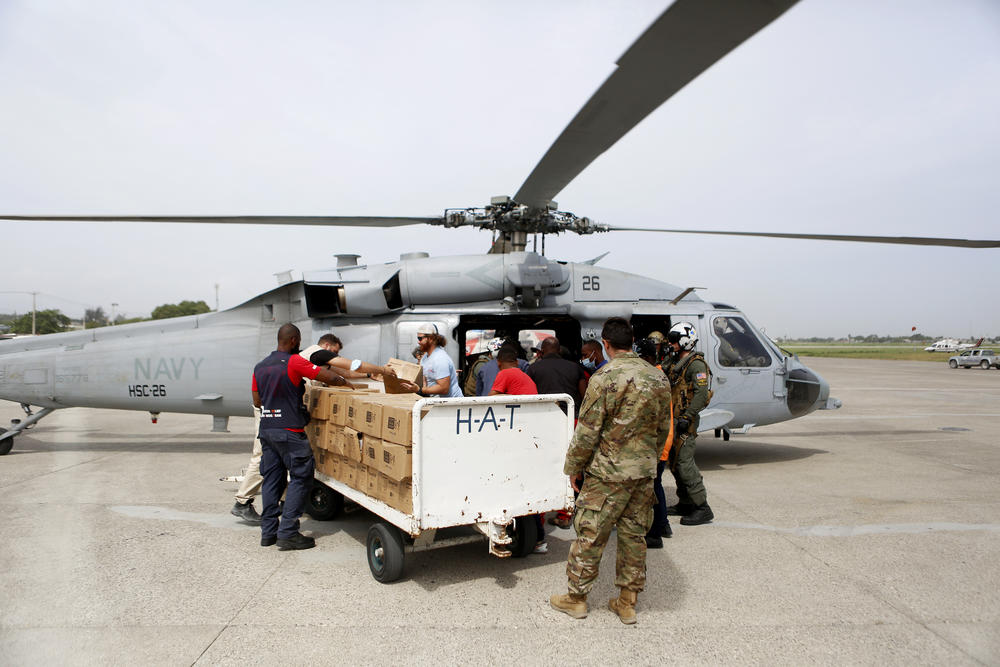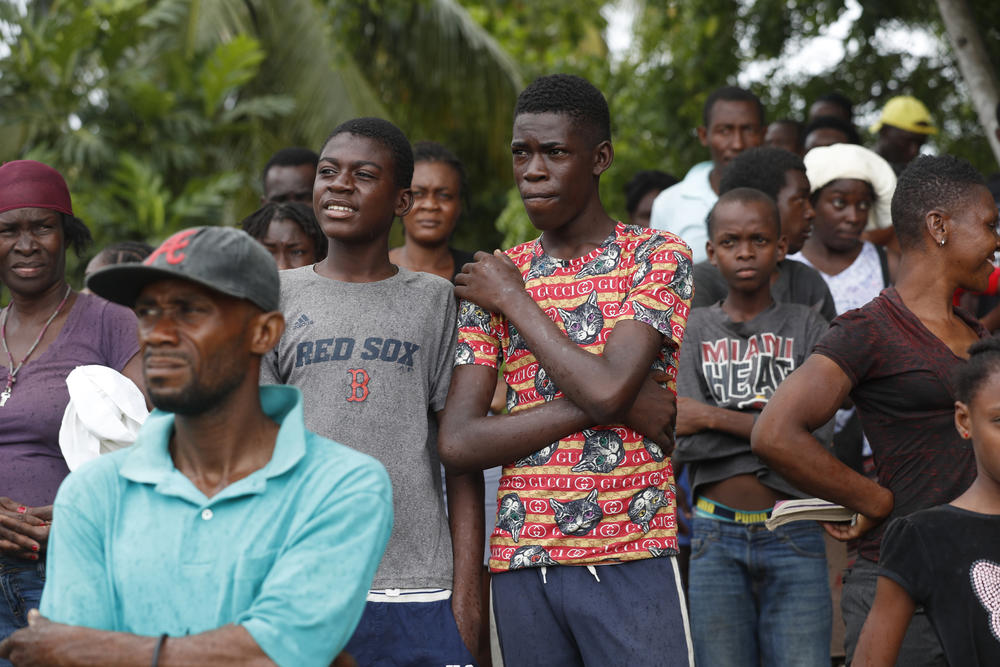Section Branding
Header Content
Almost 2 Weeks After The Quake, Aid Is Just Getting To Some Remote Towns In Haiti
Primary Content
BARADÈRES, Haiti — By the time the U.S. military helicopter touched down at the lone soccer field in the remote hillside town of Baradères, hundreds of Haitians stood in a ring around the field, men, women and children alike.
Out of the back of the Chinook, a handful of soldiers tossed out 4,500 pounds of cardboard boxes packed with rice, leaving them piled in a heap at center field. After just 10 minutes on the ground, the helicopter was gone, flying on to the next remote town full of people in need.
Eleven days after a magnitude 7.2 earthquake killed 2,200 people and destroyed 50,000 homes in Haiti's southern peninsula, humanitarian groups and Haitians alike say that aid is only just now reaching some of the region's most remote communities. And residents say their needs are greater than what they're receiving.
Haiti's mountainous southern peninsula is full of small communities that are typically accessible only by dirt road or footpaths. This month's earthquake shook loose mudslides and rocks that are now blocking access. In this region, there are few airfields, and the steep, wooded terrain makes for difficult landing by helicopter. In many places, the only clearing large enough for a helicopter to land is the town soccer field.
As a result, towns like Baradères – a small village tucked in a mountain valley, whose population of roughly 2,000 people are mostly subsistence farmers living in simple, fragile homes made of concrete blocks and sheet metal – have had to wait a week or more for significant aid to begin arriving.
Across Haiti, the U.S. Agency for International Development has distributed some 163,000 pounds of food aid, along with medical supplies and tarps. But the agency said its workers are still working to reach remote areas; they finally arrived in Baradères for the first time on Monday, along with another town called Anse-a-Veau.
"The earthquake struck and destroyed houses. People were injured. We have victims, and no hospitals to go to," said 14-year-old Edmund Lobobouin, one of the hundreds of Baradères residents who turned out Wednesday for the aid delivery. He added that at least five of his family members had been injured in the earthquake.
In addition to the unmet needs for food and shelter, providing medical care becomes more critical as time passes. Injuries that may once have been relatively simple to treat, like scratches and broken bones, become complicated by tetanus or sepsis.
Some 12,000 people were injured in the earthquake, according to Haiti's Department of Civil Protection, the federal agency overseeing the disaster response. U.S. helicopters have evacuated at least 430 injured Haitians out of the affected region to health care facilities in Port-au-Prince and elsewhere, where American medics are still working to treat the injured alongside the international aid agency Doctors Without Borders, other humanitarian groups and Haitian health care workers.
Adding to the desperation is the fact that this region was previously devastated by Hurricane Matthew in 2016. In Baradères, about 90% of families who'd owned farms, gardens or livestock had them wiped out by the Category 4 storm, one aid group found.
"I think it's very telling to see just how desperate some of these people are when we show up," said Col. Steve Gventer, the commander coordinating many of the relief flights. "People are really desperate and they will — it's not aggressive towards us. It's aggressive to get something that they can help their families, help themselves."
Gventer's unit, Joint Task Force-Bravo, normally based in Honduras, arrived in Haiti less than 24 hours after the earthquake. The U.S. military presence was requested and so far continues to be supported by Haitian officials.
Some aid distributions in recent days have been chaotic. Crowds have swarmed aid trucks and airfields. In the southwest port city of Les Cayes, a fight broke out when a bodyguard traveling with former president Michel Martelly handed out an envelope of cash. Gang activity has plagued many roads in the country, including the main highway from Port-au-Prince to Les Cayes, and charities have reported looting of trucks carrying aid.
As a result, USAID depends on the U.S. military for help delivering aid, especially in the mountainous regions. But the military does not actually distribute the aid to residents, Gventer said. That is left up to aid groups and local officials to coordinate among themselves.
"It's very tough for us to deliver and then walk away and not know what happens after that," Gventer said.
"What we've seen none of is any kind of organized crime or organized local thuggery or anything grabbing hold of stuff. That's not happening," Gventer said. "It's not being taken by the local strongman, strongperson, and then auctioning it off or selling it. That is not happening that we can tell whatsoever."
In Anse-a-Veau, a coastal town roughly 30 miles to the east of Baradères, resident Pierre Jacques Mackenzy, 40, said his town had to wait more than a week after the earthquake before receiving its first aid distribution. Wednesday's delivery was the third to reach the town, he said.
As he watched soldiers unload boxes of rice, Mackenzy said he was already looking ahead to the next shipment.
"What we really need now are tents. We have so many people sleeping under the stars," he said.
A man dressed in a shirt bearing the emblem of Haiti's Civil Protection Agency agreed. Gregory Wider Karlonge, 33, described himself as the agency brigade chief charged with overseeing disaster response in this small town. He expressed frustration with previous distributions from humanitarian groups, including UNICEF, bypassing local officials.
"Workers from those organizations did not work with the mayor's office or the Civil Protection office, and did their own distribution," Karlonge said.
When asked for comment, Ndiaga Seck, a spokesperson for UNICEF, said the organization supports the work of Civil Protection in Haiti.
"UNICEF always coordinates its interventions with the departmental coordination division headed by Civil Protection, and local authorities choose areas and beneficiaries to serve," he wrote in an email.
A lack of coordination with Haitian officials was a major criticism ofAdditional reporting and production of the radio version of this story by Christina Cala. the international response during the 2010 earthquake in Port-au-Prince, when the country was flooded with relief groups that were accused of squandering hundreds of millions of dollars donated by U.S. citizens, leaving little long-term improvement to Haiti's roads, health care and poverty.
Despite the frustration, Karlonge said, the residents of Anse-a-Veau will not say no to aid.
"We have a lot of victims," he said. "And we are in a situation where people were already in need. People are hungry, and they need help. As long as we receive aid, we will use it."
Additional reporting and production of the radio version of this story by Christina Cala.
Copyright 2021 NPR. To see more, visit https://www.npr.org.
